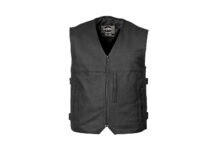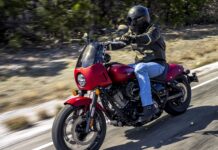Gold Valve Emulators: $169
Fork Spring Kit: $ 129
Race Tech
www.racetech.com
951.279.6655
The year was 2005. I was in the process of buying a Harley Softail. I had ridden about a dozen Harley Softail Deuces in search of just the right one. I had fallen in love with that model the first time I saw one, but after all those test rides I was beginning to think I’d never find the right one. Then I dropped by a little motorcycle shop in San Bernardino, California, that had advertised a Deuce for sale. I’ll never forget the first time I rode that 2000 Deuce. There was something different about the ride quality. I felt like I was in control of the bike but at the same time the suspension smoothed out the going beautifully. The guy who was selling the bike told me he had installed some devices he referred to as Race Tech Gold Valve Emulators. I was amazed when I discovered that such tiny devices could have such a major effect on my front suspension. Over the years I’ve had the chance to ride dozens of bikes (mostly Harleys) and for the most part I remember feeling like I couldn’t wait to get back in the Deuce’s saddle. My Emulators had spoiled me for other types of front-end suspensions.
So; how did the idea for the little wonders come about? Among his many accomplishments Paul Thede had a long and very successful career as a motocross rider. Because the suspensions in his bikes were typically adjustable, gas-charged cartridges he was known to tinker with the suspension on a regular basis. When he decided to expand his operation to include a products division (Race Tech), Paul thought he’d use the experience he had attained as a racer and address the crying need presented by front-end suspensions for cruisers and other bikes equipped with damping rods. The two major forces at work in a forks suspension involve a spring, which holds the bike up, and a device that prevents the spring from continuing to “pogo.” When damping rods are used to control spring rebound they do it by restricting the flow of fork oil as it is forced through holes drilled in the rods. You can vary the amount of damping by using fork oil with higher or lower viscosity, by varying the oil volume and by drilling more and/or larger holes in the rod but other than that it’s pretty much a one-size-fits-all system. Of course Paul understood that one size doesn’t fit all so he wanted to offer riders of cruisers and other bikes, which employed damping rods in their forks, a device that could more efficiently adapt to changing road conditions. That way a fork suspension could give a more comfortable ride and at the same time deliver the control needed to deal with challenging situations. After no small amount of experimentation our guy decided to go with a flapper valve (emulator plate) and spring combination. With the emulators installed, when the front tire encounters a small rut or bump, the main spring compresses a small amount and oil-flow force doesn’t move the spring-loaded flapper valve very much,; but when that tire hits a deep square-edged rut or large square-edged bump, the main spring compresses a lot and the compressed oil forces the spring-loaded flapper plate to open significantly in order to soften the impact of those jarring pavement anomalies.

This system enables the rider to rely on more adjustment options than oil viscosity and volume and the number and size of the holes in the damping rod. For starters, you can adjust the preload on the device’s spring by tightening or loosening the screw from one turn (least preload giving the most comfortable ride) up to four turns (most preload giving the firmest ride). You can also use different weight springs for the emulators. There’s a 26-pound spring, a 40-pound spring, a 60-pound spring and a 101-pound spring for the ultimate in rebound damping. Plus when you use a Race Tech mainspring you have five choices ranging from their 0.8 kg/mm compression-rated spring ascending in increments of 0.05 kg/mm up to a 1.0 kg/mm compression-rated mainspring. The spring kit includes a spacer (a length of 3/4 inch PVC pipe). This spacer can be trimmed to diminish the amount of preload on the main spring to give a more comfortable ride or you can use a longer-length spacer to firm up the ride.
When he installed the Emulators and the springs in the forks of my 2008 Softail Custom Tony Marasco, a suspension specialist at the Race Tech facility, drilled four more 5/16″ holes in my damping rods and reamed out the existing two holes to the same diameter so that while the rods would continue to occupy their designated position they would have very little effect on the damping process. He also polished my upper fork tubes in such a way as to give their surfaces a crosshatch effect like on cylinder walls in an engine. That way they would be able to distribute oil more evenly and the process would reduce friction.

Once I had put about 50 miles on my Custom with the Emulators installed I noticed that the suspension still felt a little too firm so I went back to the Race Tech facility. Tony drilled another tiny hole (for a total of four) in the Emulator body, trimmed the spacer and backed off the screw on the Emulator’s spring by a turn. I noticed the difference within a few miles of leaving the shop. Now I have the same feeling I used to have with my Deuce. I can’t wait to get in the saddle and ride, in comfort, as long and as far and as often as my schedule will permit.
Paul Thede presents a detailed explanation about how his Emulators works on a couple of Youtube videos. There’s also a video that chronicles his 218.6 mph world-record run on an electric motorcycle at the Bonneville Salt Flats.



















very informative, thank you…